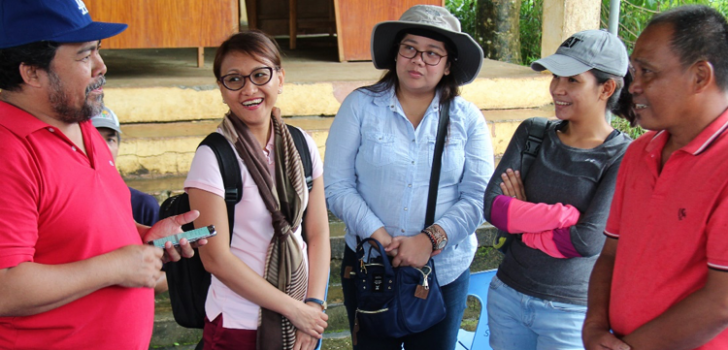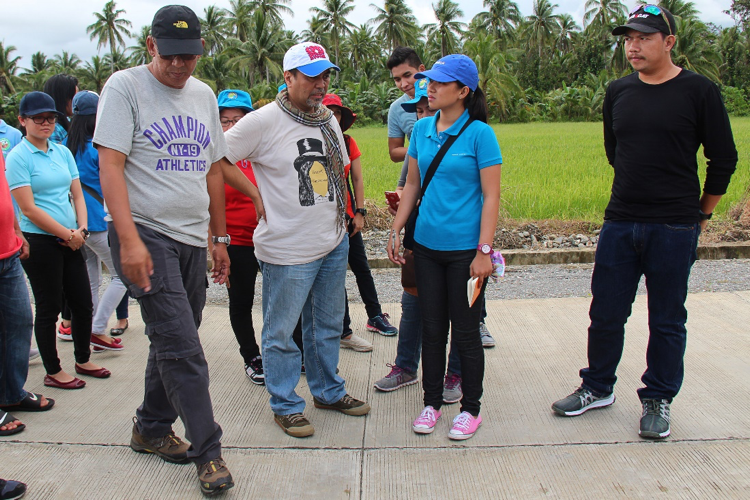 (L – R) Social and Environmental Safeguards Unit specialists Jonas Bautista and Marivi Ladia from the World Bank, Rowena Roxas from the Regional Project Coordination Office, and Maria Iris Millendez from the Project Support Office hold a short consultation with beneficiaries led by Bagong Silang Barangay Captain Nilo Mangurali. (Photo by Leira Vic Colongon, DA-PRDP RPCO 4B InfoACE Unit)
(L – R) Social and Environmental Safeguards Unit specialists Jonas Bautista and Marivi Ladia from the World Bank, Rowena Roxas from the Regional Project Coordination Office, and Maria Iris Millendez from the Project Support Office hold a short consultation with beneficiaries led by Bagong Silang Barangay Captain Nilo Mangurali. (Photo by Leira Vic Colongon, DA-PRDP RPCO 4B InfoACE Unit) World Bank inspectorate team visits Oriental Mindoro FMRs for 3rd review mission
Two farm-to-market roads (FMRs) from the municipalities of Victoria and Baco in Oriental Mindoro were the infrastructure development (I-BUILD) sub-projects visited by the World Bank team during its third implementation support mission to the South Luzon Cluster. The activity, with the national, cluster, regional, and provincial counterparts of the Department of Agriculture, aimed to assess the progress of the Philippine Rural Development Project in terms of its overall development objectives.
“And the process of assessing the progress will help you identify how else we can improve it; or if there are issues and concerns, how to resolve it. We are not here to find faults, we are here to help you because our objective is really good quality project,” said Jonas Bautista, a specialist on environmental safeguards.
The site inspection was first conducted at Barangay Bagong Silang to Macatoc FMR which is a 2.79-kilometer access road that connects to the provincial road and market in Victoria, the largest producer of calamansi in the province. It was recently declared complete with around 7,219 individual or 1,570 household beneficiaries from the said area and neighboring barangays of Antonino, Loyal, and San Gabriel.
“Hindi po namin malilimutan itong proyekto na ibinigay ninyo sa amin,” shared Nilo Mangurali, Barangay Captain of Bagong Silang, during the consultation with beneficiaries led by the Social and Environmental Safeguards (SES) unit.
The consultation primarily focused on the perspective of the community on their participation in the construction of the sub-project from its proposal to completion. It also allowed the visiting specialists to recommend measures on how the members of the community can take initiative in maintaining the condition of the new road.
Among others, the barangay local government unit is encouraged to create an ordinance limiting the load of large vehicles passing by the area. Farmers only usually use jeepneys and tricycles in transferring their goods, however, there are instances where trucks and other similar vehicles also use the road. At the same time, the regulation can foster the involvement of the community in activities that will promote good housekeeping practices.
Mangurali, who served as the focal person during the discussion, noted the suggestions and assured the inspecting team that he and the rest of the barangay will do their best to make the most of the government-funded project. He explained that the road, just a few months after completion, has already immensely enhanced their way of life and they will be working hard to keep it that way.

(L – R) World Bank Rural Infrastructure Engineer Raoul Azanza with National Project Support Office Procurement Head Romeo Maloug, Regional Project Coordination Office Rural Infrastructure Engineer Fatima Parco, and Project Support Office I-BUILD Component Head Allan Tatierra during the site inspection at the Bagong Silang – Macatoc and Dulangan I – Dulangan II farm-to-market roads in Oriental Mindoro. (Photo by Leira Vic Colongon, DA-PRDP RPCO 4B InfoACE Unit)
“These are highly appreciated by the communities, particularly the FMRs that we had constructed. There was a decrease in travel time and, of course, the fares became more economical for them,” said Oriental Mindoro Provincial Agriculturist Christine Pine.
Pine added that the Calamansi Trading Center, the enterprise development (I-REAP) sub-project in Oriental Mindoro, had an equally positive impact to its beneficiaries. Located in Calapan City, it was able to provide an alternative market for the calamansi farmers in the province. During peak season, there is an abundant supply of calamansi but farmers are only able to sell a portion of their produce because of limited market.
On the other hand, the 5.31-kilometer Barangay Dulangan I to Dulangan II FMR which is similarly connected to the provincial road in Baco was also evaluated. It has more than fifty percent of physical progress and will benefit around 10,226 individuals or 2,155 households from its influence area which includes the other barangays of San Ignacio, Bangkatan, Lantuyan, and Tagumpay.
According to Engineer Raoul Azanza, a specialist on rural infrastructures, both FMRs are substantially good although there are still minor deficiencies that need to be taken care of. At the exit meeting, the P12.87M-worth construction of the bridge along Bagong Silang to Macatoc FMR was also included in the sub-projects presented.
The inspectorate team, joined by the Provincial Project Management and Implementation Unit and Regional Project Coordination Office, shared their findings from the inspection with the corresponding actions to be done by the concerned offices. Aside from this, it also provided an opportunity for the said agencies to be aware of the potential interventions that could foster further advancement in the said areas.
“We have the support and you can see the involvement of every sector. These are the things that really would make a province progressive. Nakikita natin ang talagang kaunlaran sa pagtutulungan. And these projects that you will leave with us will long be there long after we are gone,” said Oriental Mindoro Provincial Administrator Nelson Melgar who spoke on behalf of Provincial Governor Alfonso Umali.
The third implementation support mission in the South Luzon cluster was a two-part activity conducted in the provinces of Oriental Mindoro for the I-BUILD component and Quezon for the I-REAP component. The exit conference with the World Bank mission team led by agriculture economist Frauke Jungbluth was held in Lucena City where the different component and unit heads from the cluster presented their respective accomplishments and plans for the Project. ### (Leira Vic Colongon, DA-PRDP RPCO 4B InfoACE Unit)
